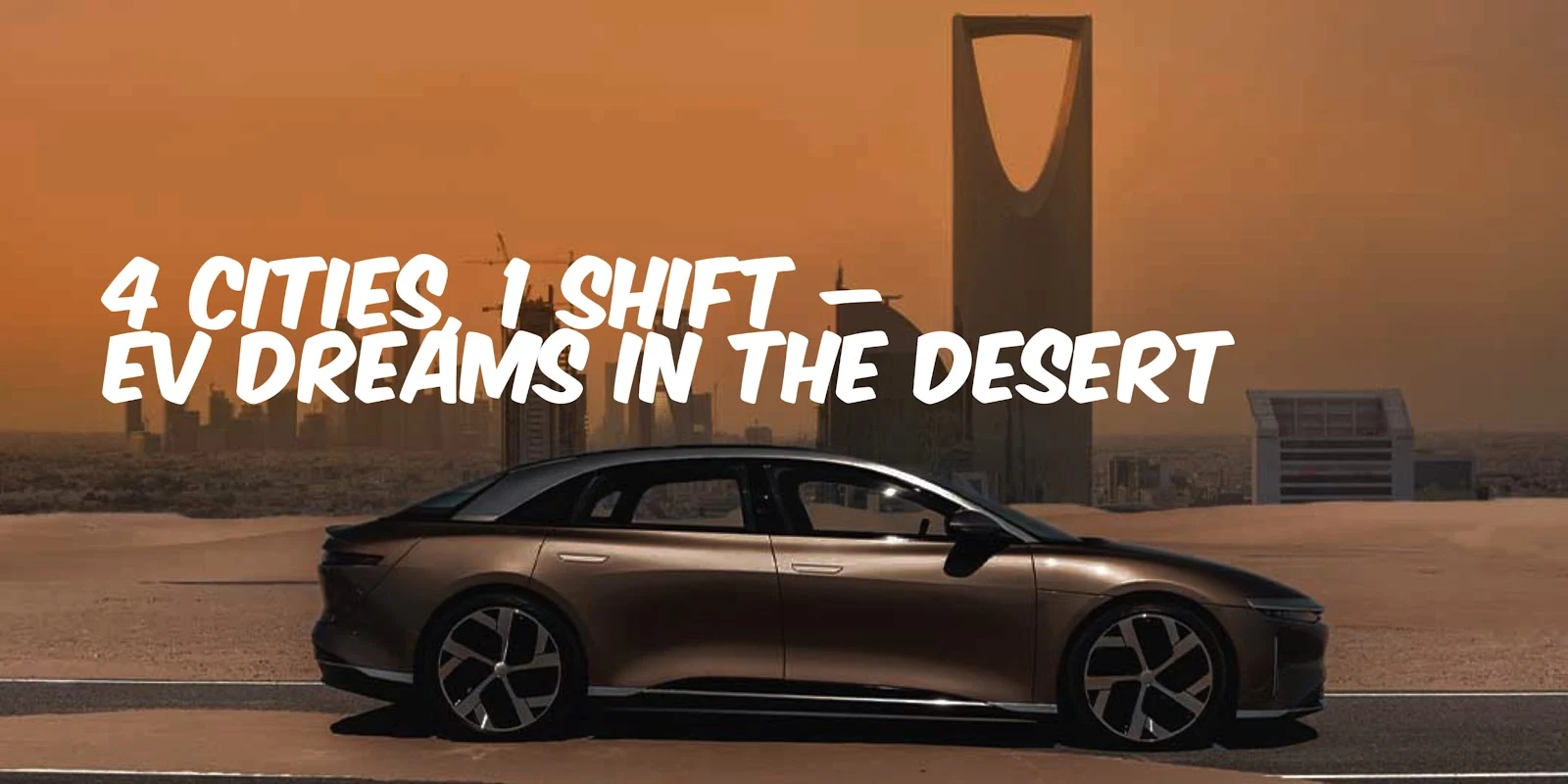From Oil to Electric – Decarbonization Experiments in Middle Eastern Cities
Electric vehicle (EV) transition is becoming a new trend in the Middle East. Despite their deep reliance on oil, several cities are moving swiftly to test electrification strategies.
This article focuses on four cities—Riyadh, Dubai, Neom, and Tel Aviv—to explore the possibilities and limitations of EV adoption in the region. We analyze national strategies, city-level policies, and market responses.
The EV shift in the Middle East goes beyond environmental issues—it's a strategic move to reshape economic structures and diversify industries. Each city reveals how oil-based economies are planning long-term transitions toward clean energy mobility.
Cities Move First, While Oil Still Powers the Region
Middle Eastern cities are adopting EV policies with both symbolic and strategic intent. While oil remains the region’s main export, domestic transportation systems are increasingly targeted for decarbonization.
These shifts are driven by a mix of climate commitments, national branding, and infrastructure modernization goals. Though speeds and depths of transition vary, the push toward electrification is undeniable.
Riyadh – Between Symbolism and Reality
As part of Saudi Arabia's Vision 2030, Riyadh has positioned itself as a flagship for EV transition. The city is home to large investments in Lucid Motors and its new manufacturing plant.
Saudi Arabia also launched its first domestic EV brand, CEER, in 2022. EV infrastructure development is centered around public institutions and industrial zones.
However, public EV adoption remains low, and infrastructure is still in its early stages. The focus is currently on public sector fleets, with private adoption expected to take more time.
Dubai – The Arab Smart City Goes Electric
Dubai is one of the fastest cities in the region to roll out EV infrastructure. The “Green Charger” program by DEWA has installed thousands of charging stations across the city.
Public vehicles are expected to reach 100% electrification, while regulations for commercial fleets are gradually tightening.
Dubai’s EV policies are tightly linked to its 2050 Net Zero initiative, reflecting a strong alignment between environmental goals and transportation policy.
Neom – A Testbed Where Only EVs Exist
Neom, a futuristic mega-city project in Saudi Arabia, is designed with no space for internal combustion engines. The city will feature autonomous EVs, aerial mobility, and smart logistics.
Because Neom’s urban layout is entirely electric by design, EVs will serve as the default mode of transportation.
However, the project is still under construction, and real-world operational sustainability remains to be seen.
Tel Aviv – European-Style Transition Led by the Market
Tel Aviv stands out in the Middle East with rapid private-sector-led EV adoption. With policy frameworks similar to Europe, brands like Tesla and Hyundai have high market shares.
Incentives include charging station subsidies, registration tax reductions, and mandatory charger installation in new buildings.
Tel Aviv is widely seen as the only city in the region with a consumer-driven EV market.
Charging Infrastructure and Subsidy Policies
- Riyadh: Ultra-fast charging infrastructure is being built around the Lucid factory, with a goal of 5,000 stations by 2030. Subsidies are mostly targeted at public and industrial sectors, with limited support for private EVs.
- Dubai: Over 1,000 chargers have been installed, primarily in city centers and public parking areas. DEWA is also developing a smart charging network. EV buyers receive tax exemptions, free charging, and toll discounts.
- Neom: The city is being developed as a fully electric zone. Infrastructure will include autonomous and wireless charging technologies. As the project is still in early phases, specific subsidy schemes are yet to be disclosed.
- Tel Aviv: Joint efforts by the national and local governments are expanding residential charging infrastructure. Commercial areas also benefit from installation incentives. Buyers can receive up to 40% off registration taxes.
Public Acceptance and Market Response
- Riyadh: Interest in EVs is rising, but concerns remain over price and access to chargers. Some progress is seen among affluent consumers who associate EVs with modernity.
- Dubai: EV demand is growing rapidly among high-income and tech-savvy groups. Vehicle performance and brand reputation heavily influence market behavior, aided by government promotion campaigns.
- Neom: With few residents, public sentiment is hard to measure. Still, expectations are high, and Neom’s futuristic appeal plays a role in attracting attention to the project.
- Tel Aviv: Younger urban dwellers and startup professionals are rapidly driving EV adoption. Consumer reviews and charging convenience are key factors in purchase decisions.
Power Balance – National vs. Local Governments
Most Middle Eastern countries have strong centralized governments, but city-level initiatives are advancing quickly. Dubai and Neom exemplify high alignment between national vision and urban execution.
Tel Aviv, under a more decentralized system, leads in local-level experiments and public-private partnerships in the EV space.
Conclusion – Symbolic Shift or Genuine Transformation?
The Middle East's EV transition is more than a technological upgrade—it represents shifts in strategy, competitiveness, and global image.
Riyadh focuses on symbolism, Dubai emphasizes policy execution, Neom embodies futuristic design, and Tel Aviv showcases consumer-led change.
The future beyond oil is already underway in the Middle East—starting with its cities and their electric ambitions.
In the next installment, we will explore the EV transition strategies of key cities in Oceania.
These changes are not just local experiments. They signal that the Middle East is becoming a testing ground where electricity and innovation are replacing oil as the drivers of urban mobility.
If successful, these cities could become new role models for energy-exporting nations and emerging markets worldwide.

Comments
Post a Comment